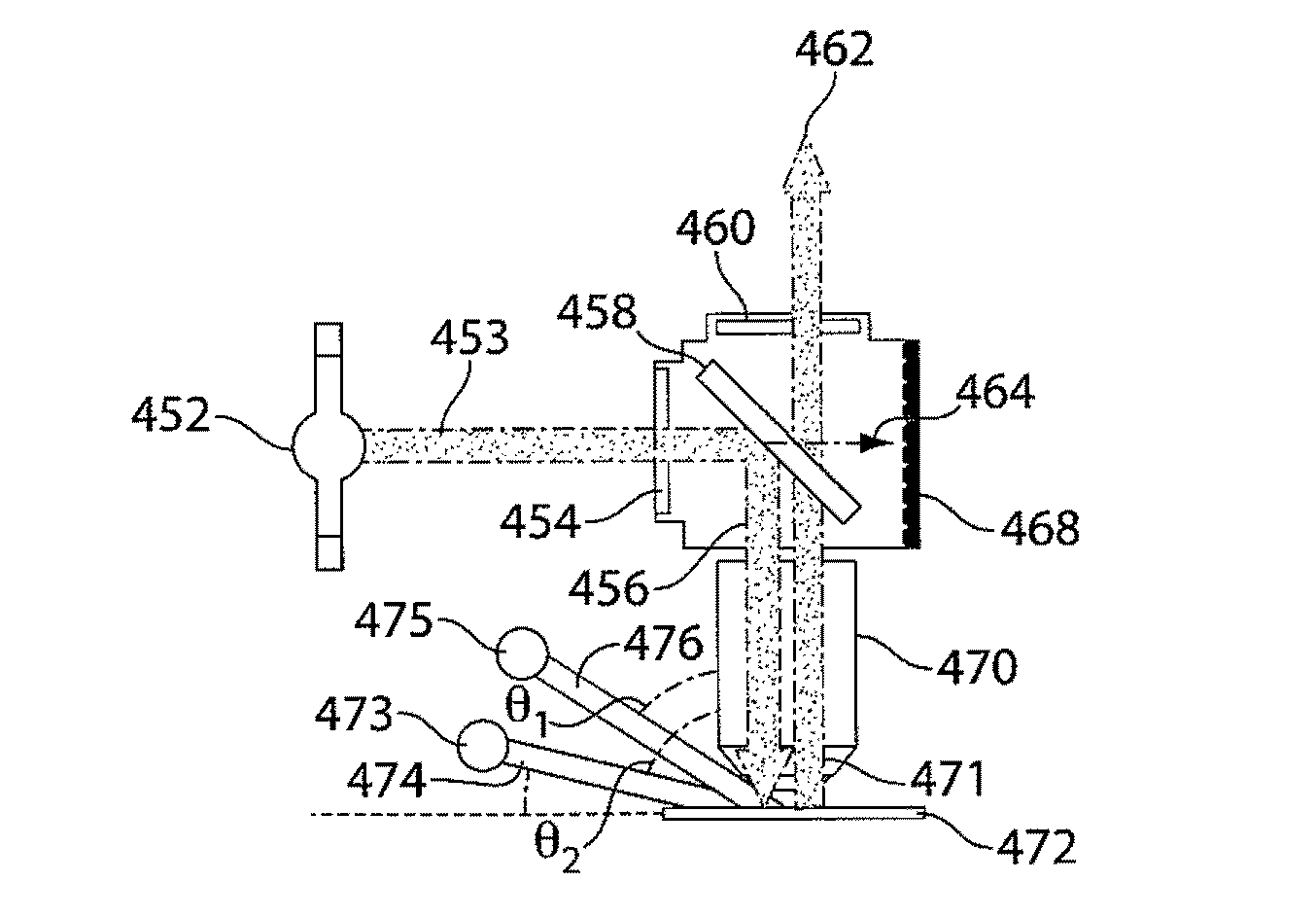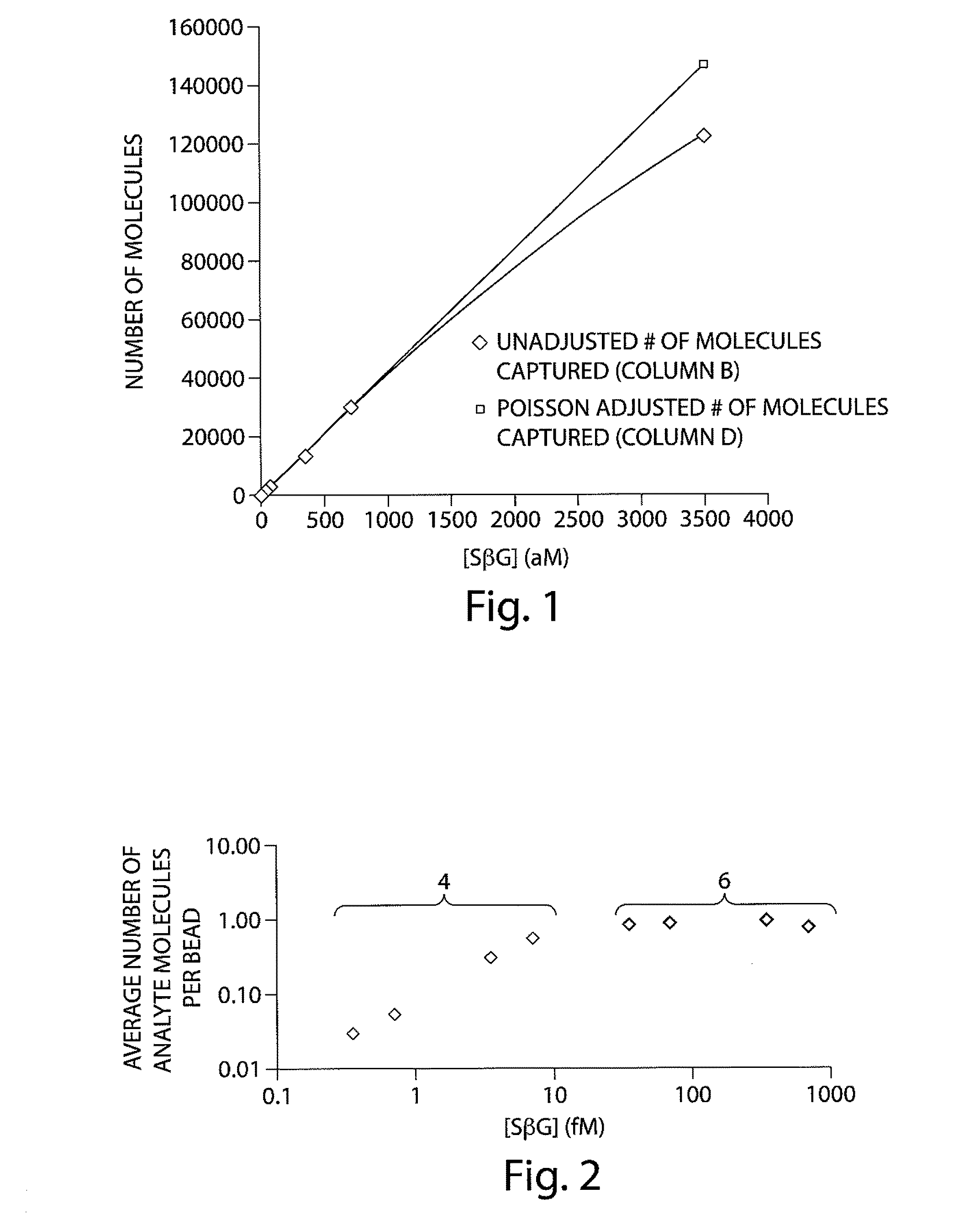Methods and systems for extending dynamic range in assays for the detection of molecules or particles
a technology of dynamic range and assay, applied in the direction of material analysis, suspension and porous material analysis, instruments, etc., can solve the problem of many known methods and techniques limited
- Summary
- Abstract
- Description
- Claims
- Application Information
AI Technical Summary
Benefits of technology
Problems solved by technology
Method used
Image
Examples
example 1
[0144]This following example describes materials used in Examples 2-22. Optical fiber bundles were purchased from Schott North America (Southbridge, Mass.). Non-reinforced gloss silicone sheeting was obtained from Specialty Manufacturing (Saginaw, Mich.). Hydrochloric acid, anhydrous ethanol, and molecular biology grade Tween-20 were purchased from Sigma-Aldrich (Saint Louis, Mo.). 2.7-μm-diam. carboxyl-terminated magnetic beads were purchased from Varian, Inc. (Lake Forest, Calif.). 1-ethyl-3-(3-dimethylaminopropyl)carbodiimide hydrochloride (EDC), N-hydroxysulfosuccinimide (NHS), and SuperBlock® T-20 Blocking Buffer were purchased from Thermo Scientific (Rockford, Ill.). Streptavidin-β-galactosidase (SβG) was purchased from Invitrogen or conjugated in house using standard protocols. Resorufin-β-D-galactopyranoside (RGP) was purchased from Invitrogen (Carlsbad, Calif.). The fiber polisher and polishing consumables were purchased from Allied High Tech Products (Rancho Dominguez, Cal...
example 2
[0145]The following describes a non-limiting example of the preparation of 2.7-um-diameter magnetic beads functionalized with biotin for capture of the exemplary analyte, SPG. Beads functionalized with DNA capture probe (5′-NH2 / Cl2-GTT GTC AAG ATG CTA CCG TTC AGA G-3′) were prepared according to the manufacturer's instructions. These beads were incubated with 1 μM of biotinylated complementary DNA (5′-biotin-C TCT GAA CGG TAG CAT CTT GAC AAC-3′) overnight (16 h) in TE buffer containing 0.5M NaCl and 0.01% Tween-20. After incubation, the beads were washed three times in PBS buffer containing 0.1% Tween-20. The bead stock was distributed into a microtiter plate giving 400,000 beads per well in 100 μL. The buffer was aspirated from the microtiter plate wells, the beads were resuspended and incubated with various concentrations of SPG in Superblock containing 0.05% Tween-20 for 5 h. The beads were then separated and washed six times with 5×PBS buffer containing 0.1% Tween-20.
example 3
[0146]The following describes a non-limiting example of the preparation of microwells arrays. Optical fiber bundles approximately 5-cm long were sequentially polished on a polishing machine using 30-, 9-, and 1-micron-sized diamond lapping films. The polished fiber bundles were chemically etched in a 0.025 M HCl solution for 130 seconds, and then immediately submerged into water to quench the reaction. On average, the wells etch at a rate of approximately 1.5 to 1.7 μm per minute. Therefore, wells of 3.25 um depth are produced in about 115 to 130 s. To remove impurities from etching, the etched fibers were sonicated for 5 s and washed in water for 5 min The fibers were then dried under vacuum and exposed to air plasma for 5 min to clean and activate the glass surface. The arrays were silanized for 30 minutes in a 2% solution of silane to make the surfaces hydrophobic.
PUM
| Property | Measurement | Unit |
|---|---|---|
| concentration | aaaaa | aaaaa |
| affinity | aaaaa | aaaaa |
| optical techniques | aaaaa | aaaaa |
Abstract
Description
Claims
Application Information
 Login to View More
Login to View More - R&D
- Intellectual Property
- Life Sciences
- Materials
- Tech Scout
- Unparalleled Data Quality
- Higher Quality Content
- 60% Fewer Hallucinations
Browse by: Latest US Patents, China's latest patents, Technical Efficacy Thesaurus, Application Domain, Technology Topic, Popular Technical Reports.
© 2025 PatSnap. All rights reserved.Legal|Privacy policy|Modern Slavery Act Transparency Statement|Sitemap|About US| Contact US: help@patsnap.com



